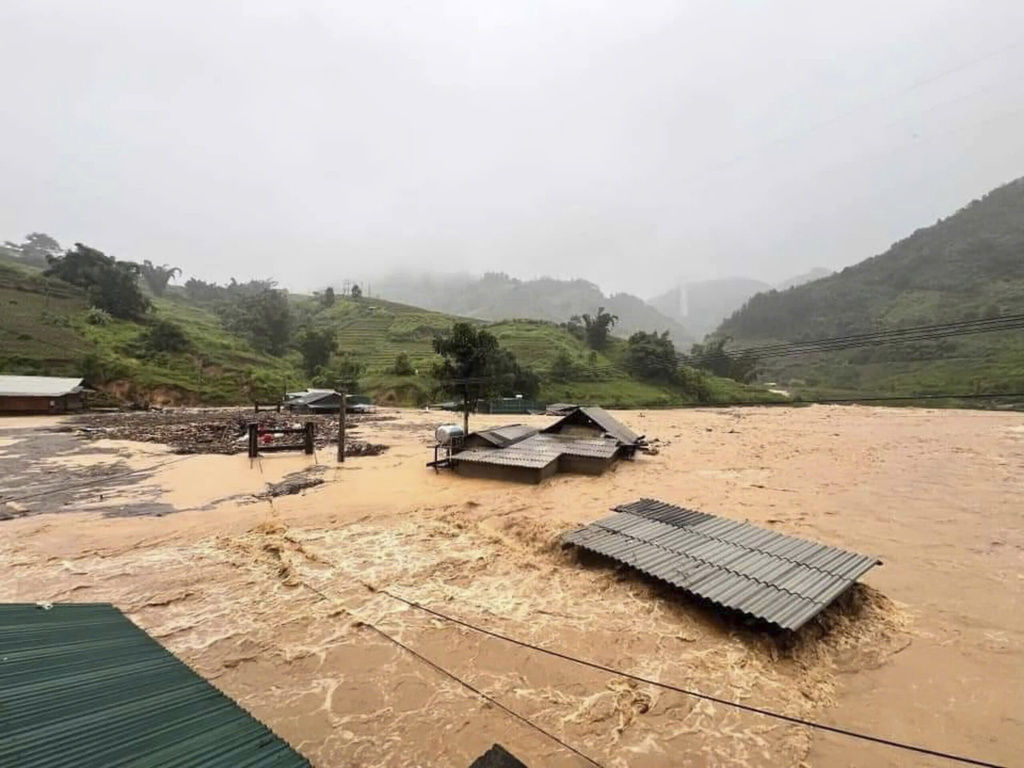
At least 14 people have died and 176 others have been injured in Vietnam after Typhoon Yagi slammed the country’s north, state media says, as officials warn of heavy downpours despite its waning power.
Described by Vietnamese officials as one of the most powerful typhoons to hit the region over the last decade, Yagi left more than 3 million people without electricity in northern Vietnam on Sunday.
It also damaged vital agricultural land, nearly 116,192 hectares where rice and fruits are mostly grown. Hundreds of flights were cancelled after four airports were closed.
The typhoon made landfall in Vietnam’s northern coastal provinces of Quang Ninh and Haiphong with wind speeds of up to 149km/h on Saturday afternoon. It raged for roughly 15 hours before gradually weakening into a tropical depression early Sunday morning.
Vietnam’s meteorological department predicted heavy rain in northern and central provinces and warned of floods in low-lying areas, flash floods in streams and landslides on steep slopes.
Municipal workers along with army and police forces were busy in the capital, Hanoi, clearing uprooted trees, fallen billboards, toppled electricity poles and rooftops that were swept away, while assessing damaged buildings.
Before landing, strong winds felled a tree, killing a woman in the capital, Hanoi, local media said Saturday.
Quang Ninh is home to the UNESCO World Heritage site Ha Long Bay, known for its many towering limestone islands.
Hundreds of cruises were cancelled at the popular site before the typhoon landed, according to local media.
READ MORE: Young driver dies after car smashed to pieces in horror Perth crash
READ MORE: Sydney teacher accused of child grooming offence out on bail
Haiphong is an industrial hub, home to large factories, including EV maker VinFast and Apple supplier Pegatron.
The typhoon also triggered power outages in large parts of Quang Ninh and Thai Binh provinces.
Earlier, the government issued several alerts, and those vulnerable to floods or landslides were evacuated. Four airports were shuttered, including in Hanoi, and Haiphong.
Authorities pruned trees in Hanoi to make them less susceptible to falling, but wind and rain knocked over several along with billboards in northern cities.
Local media reported that many moored boats were swept out to sea.
“I am going to stay inside and try and stay safe with my family,” said Bao Ngoc Cao, 24, a businesswoman from Hanoi.
She added that the last time a typhoon this strong hit Vietnam was in 2013 and that storms usually weaken before reaching the capital.
“But we still need to be prepared,” she said.
On Friday afternoon, Yagi struck the Chinese city of Wenchang in Hainan province with wind speeds of up to about 245km/h near its centre.
Authorities said the typhoon left three people dead and nearly 100 others injured in the province.
It had affected more 1.2 million people as of noon Saturday, according to the local Global Times newspaper.
Some 420,000 Hainan residents were relocated before the typhoon’s landfall. Another half a million people in Guangdong province were evacuated before Yagi made a second landfall in the province’s Xuwen County on Friday night.
READ MORE: Police look overseas for alleged suspect who scalded baby at park
Before leaving Hong Kong, Yagi forced more than 270 people to seek refuge at temporary government shelters on Friday, and more than 100 flights in the city were cancelled due to the typhoon.
Heavy rain and strong winds felled dozens of trees, and trading on the stock market, bank services and schools were halted.
Yagi was still a storm when it blew out of the north-western Philippines into the South China Sea on Wednesday, leaving at least 20 people dead and 26 others missing mostly in landslides and widespread flooding and affecting more than 2.3 million people in northern and central provinces.
More than 82,200 people were displaced from their homes in Philippine provinces, and classes, work, inter-island ferry services and domestic flights were disrupted for days, including in the densely populated capital region, metropolitan Manila.
Benjamin Horton, director of the Earth Observatory of Singapore said that storms like typhoon Yagi were “getting stronger due to climate change, primarily because warmer ocean waters provide more energy to fuel the storms, leading to increased wind speeds and heavier rainfall”.
Climate change was also causing storms to potentially move to different locations with studies by the observatory showing that the latitude where storms peaked in their intensity was shifting, exposing newer areas to the impacts of storms, he added.
Horton said that protecting natural systems ranging from reefs to rivers while building structures that were more resilient to strong winds and flying debris and improving existing infrastructure were all measures that could help countries better deal with strong typhoons.
links to content on ABC
9News





